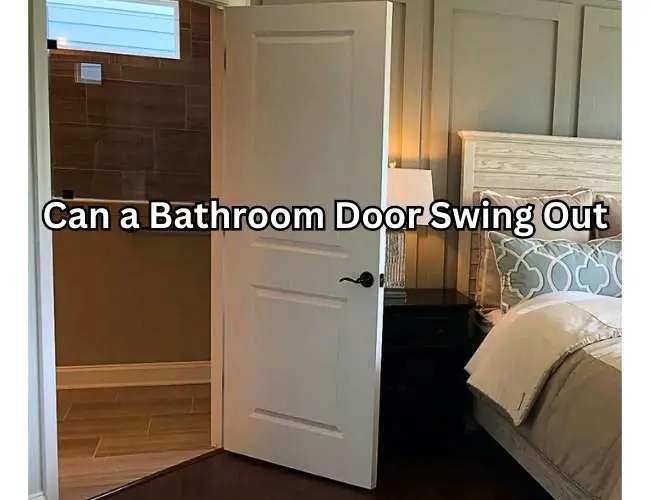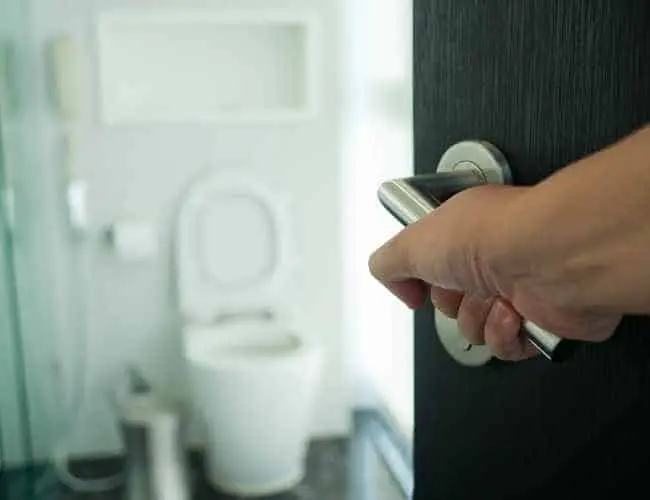How interesting can a discussion about bathroom doors be? Far more than you might expect! Consider this: the direction in which your bathroom door swings might seem like a tiny detail, but it carries a surprising amount of impact. From practicality to safety, a lot rides on this one aspect.
In this blog, we’ll sate your curiosity on one unusual question: Can a bathroom door swing outward?
Technically, yes, it absolutely can. But should it? Most often, the answer is no. It’s generally better for a bathroom door to swing inward. As we navigate through the layers of this topic, you’ll discover the underlying reasons.
So, buckle up for a light-hearted exploration of bathroom doors and their swinging secrets!

Can a Bathroom Door Swing Outward?
Let’s shake things up a little and imagine a scenario where your bathroom door swings outward, quite contrary to what you’re used to seeing. Possible? Absolutely!
If you thought doors can only swing one way, prepare for a surprise! A bathroom door can indeed swing out, much like doors you see at retail stores or office buildings. Although this design choice doesn’t seem to follow any written rule or regulation, it carries its own set of perks.
Firstly, in certain cases such as small bathrooms where space is a luxury, an outward swinging door can provide that crucial extra room. More space to move around or fit fixtures might just be the saving grace in a cramped environment. In fact, you might even stumble upon instances where an outward-swinging door is a necessity for functionality.
For instance, in bathrooms for the differently-abled, door swings can be vital for accessibility. Here, an outward swing could dramatically simplify access, providing the necessary ease of movement for a wheelchair, for example.
That said, let’s not forget the occupants of the house beyond the bathroom. With an outward-swinging door, we need to watch out for unsuspecting passersby in the hallway or adjacent spaces. We certainly don’t want our bathroom doors causing a conundrum elsewhere, do we?
In a nutshell, while the norm may be the familiar inward swing, rest assured, your bathroom door can most certainly venture in the opposite direction. Though, as we’ll go on to discuss, there are reasons why the inward swing is generally preferred. But for now, let it be known that a door swinging outward is not just possible but can be quite handy under the right circumstances.
Why Are Most Bathroom Doors Designed to Swing Inward?
Now that we’ve established that bathroom doors can swing both ways, it’s time to explore why the majority adhere to the inside swing. It’s not a mere coincidence. Instead, several factors contribute to making the inward swing the go-to option in residential and commercial designs.
1. Safety First:
Have you ever considered what might happen in a little accident where someone unwittingly locks themselves in the bathroom? A door swinging inward could make a substantial difference. In such situations, an inward-swinging door might make it easier for others to reach the individual and offer assistance, if need be.
2. Avoiding Hallway Hazards:
When a door swings outward, it increases the chance of unintentionally hitting someone walking by in the hallway or causing a potential obstruction. In contrast, an inward swinging door only ‘intrudes’ into the bathroom, making the hallway a much safer zone.
3. Spatial Consideration:
When you open an outward-swinging door, the full width of the door frame gets exposed, creating an illusion of a larger space. However, if privacy isn’t much of a concern – this might not be very pleasing aesthetically. An inward-swinging door, on the other hand, maintains a more uniform facade in the rest of the house or the building.
4. Maintaining Privacy and Aesthetics:
Doors typically have their locks and hinges on the side they swing towards. An inward-swinging bathroom door ensures the lock is inside, enhancing privacy. Additionally, seeing a door swing into a ‘private’ zone like a bathroom gives a subconscious cue to onlookers, reminding them to respect the sanctuary of the space.
5. Ventilation and Odour Control:
Nobody enjoys the aftermath of a ‘fragrant’ visit to the bathroom lingering in the hallway or the nearby area. An inward-swinging door can contain these odours better than an outward one, ensuring that the air freshener does its work mostly inside the bathroom itself!
To summarize, here’s a table capturing the reasons behind bathroom doors swinging inwards:
| Sl No. | Reasons for Inward Swing |
|---|---|
| 1. | Safety considerations |
| 2. | Avoiding hallway hazards |
| 3. | Spatial considerations |
| 4. | Privacy and aesthetics |
| 5. | Ventilation and odour control |
In the end, while an outward-swinging door comes with its applications and advantages, these are the reasons we mostly find bathroom doors designed to swing inward. It’s a blend of practicality, safety and aesthetics that has stood the test of time.

What are the Potential Issues with Outward Swinging Bathroom Doors?
While outward swinging bathroom doors have their uses, especially in unique circumstances, they do come with a set of drawbacks of their own. Here are some potential issues you may encounter:
1. Space Intrusion:
Outward swinging doors may intrude into the hallway, bedroom, or whatever space lies outside the bathroom. This intrusion can cause inconvenience by blocking the path or creating obstructions, especially in compact houses where every inch counts.
2. Safety Concerns:
There’s always that chance that an open bathroom door might unexpectedly meet someone passing by. They might walk into it or, worse, get struck by it being opened. So, it’s potential “ouch” moments waiting to happen!
3. Aesthetic Balance:
Many prefer the uniform and uninterrupted look of doors swinging into the rooms they serve — be it a bedroom, kitchen, or bathroom. An outward-swinging door can disrupt this aesthetic balance.
4. Accessibility Problems during Emergencies:
In an emergency scenario, let’s say, where someone feels unwell in the bath, an outward-swinging door might hinder access for help. An inward-swinging door, on the other hand, can make such situations easier to handle.
5. Privacy Exposure:
Hinges are typically located on the side that a door opens into. Therefore, a door swinging outwards puts the hinges on the outside, making the bathroom potentially less secure.
In a nutshell, here are the potential issues with outwardly swinging doors:
| Sl No | Potential Issues with Outward Swing |
|---|---|
| 1. | Space Intrusion |
| 2. | Safety Concerns |
| 3. | Aesthetic Balance |
| 4. | Accessibility during Emergencies |
| 5. | Privacy Exposure |
While outward-swinging bathroom doors have their place in specific scenarios, these potential problems highlight why inward swings tend to be the popular choice. However, depending on the layout and specific needs of your space, it’s good to weigh these issues against the benefits before deciding on the swing direction.
Is it Possible to Change the Swing Direction of an Existing Bathroom Door?
Yes, You can change the swing direction of an existing bathroom door.
The process involves reversing the door hinges and turning the door to place the hardware on the opposite side. Remember that this will likely be a bit of a DIY project, so if you’re not handy with tools, it could be prudent to hire a professional.
Here is a simplified process for how you’d go about it:
1. Preparation: Start by removing the existing door, hinges, and strike plate from the doorjamb.
2. Transfer Hinge Locations: You’ll then need to use a router or chisel to create new hinge and strike plate recesses on the opposite jamb. It’s the artisan phase of this task so take it slow and aim for precision.
3. Adjust the Door: Once new recesses are ready, flip your door to align it with the new hinge and strike plate locations. You might need to drill new holes on the door for hinges.
4. Assemble: After the adjustments, it’s time to attach your door back to the frame. Secure the hinges inside the new recesses on the door and the jamb.
5. Check the Swing: Finally, test your door to ensure it swings correctly in its new direction. You may have to adjust the door stop to ensure it aligns properly when closed.
Remember, when reversing the door swing, you might also need to flip the door hardware, namely the lock or door handle.
Before taking on this task, try to gauge the time and labour intensity, and weigh them against the potential benefits you expect the change to bring. Door swing reorientation can be a fun weekend DIY for some. Still, for those less comfortable around tools, hiring a professional might avoid time-consuming (and potentially struggle-filled) attempts at ‘trial and error’.
Conclusion
And that brings us to the close of our intriguing exploration into the directional dilemmas of bathroom doors, underpinning our central premise – “Can a Bathroom Door Swing Out?”
As we’ve seen, while bathroom doors certainly can swing out and there can be specific situations where this makes sense, it’s generally more beneficial for them to swing inward. Factors like safety, spatial consideration, unobtrusiveness, and aesthetics sway the choice heavily towards an inward swing.
Yes, it’s possible to change the swing direction of your existing bathroom door, but it requires a bit of labour. So, the next time you notice the swing of a bathroom door or ponder over changing your bathroom door’s direction, remember the dance of the doors is more than meets the eye!
